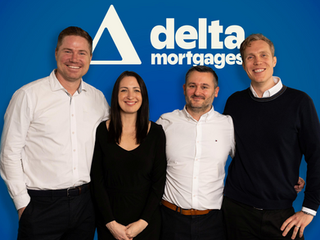
Buy-to-Let Mortgages
Whether you're a first-time landlord or growing your property empire, securing the best buy-to-let mortgage rate shouldn’t feel like a full-time job. At Delta Mortgages, we make it effortless—assessing affordability, comparing rates, and guiding you every step of the way.

First Time Buyer Landlord

Houses in Multiple Occupation (HMO) / Student Rentals

Ltd Company Mortgages

Portfolio Landlords
Get started here

Buy-to-Let Mortgages – From First-Time Landlords to Portfolio Investors
A buy-to-let mortgage is designed for properties you plan to rent out rather than live in—whether you’re purchasing a new investment, refinancing an existing rental, or turning an inherited property into a source of income.
The buy-to-let world comes with a unique set of rules, tax implications, and lender criteria—all of which can impact your options. That’s where the right mortgage advice makes all the difference.
At Delta Mortgages, we specialise in helping landlords find the right mortgage for their investment goals, whether it’s a single rental property or an entire portfolio.
Make sure you speak to a Buy-to-Let Specialist Adviser
With access to 100+ lenders and thousands of buy-to-let mortgage products, we know which lenders are best suited to your investment strategy. Our specialist mortgage brokers take the time to understand your plans and match you with the best mortgage deal available.

Quick Stress Tests
Instantly assess affordability based on rental income.

Access to the Full Buy-To-Let Market
From high-street lenders to specialist providers.

Check the Best Rates
Compare buy-to-let mortgage rates from across the market.

Zero Impact on Your Credit Score
Explore your options risk-free.
Hear from happy people
Three Simple Steps to Securing Your Buy To Let Mortgage
Investing in property is exciting—but navigating the buy-to-let mortgage process? Less so. That’s where we come in. Our experienced mortgage advisers will handle the tricky stuff, so you can focus on finding the perfect property (or counting your future rental income—no judgment here).



3
Get Your Buy To Let Mortgage Agreement in Principle
Once we’ve found your best-fit mortgage, we’ll sort your agreement in principle, so you know exactly what you can borrow before you make an offer. That way, you can move fast and snap up the right property before someone else does.
2
We’ll Search the Market for the Best Buy To Let Mortgage Rates
With access to 100+ lenders and thousands of mortgage deals, we’ll do the legwork—comparing rates, criteria, and lender quirks—so you don’t have to. No need to spend hours squinting at comparison sites; we’ve got this.
1
Speak to a Buy to Let Mortgage Adviser
Start with a free initial, no-obligation chat with one of our mortgage brokers. Whether you’re a seasoned landlord or taking the plunge for the first time, we’ll talk through your options, answer your questions, and make the whole thing a breeze.
Find Buy-to-Let Mortgage Lenders
Access the most competitive mortgage rates for buy-to-let today—tailored to your income and circumstances.
Speak with Delta Mortgages today. With access to 100+ lenders and over 14,000 mortgage products, we’ll take the time to understand your unique situation and match you with the best possible mortgage deal. Already have a mortgage in principle? No problem—it’s always worth comparing to ensure you're getting the best rate.









The Best Buy-to-Let Mortgage Deals
Whether you're planning to build a property empire, create a relaxing countryside retreat, or simply dip your toes into the rental market, a buy-to-let mortgage is your first step towards making it happen.
A buy-to-let mortgage is specifically designed for landlords who plan to rent out a property rather than live in it themselves. While it can be a fantastic way to generate passive income, navigating the process comes with its own set of challenges—lender criteria, tax implications, deposit requirements, and interest-only mortgage options all need careful consideration.
That’s where Delta Mortgages’ experienced buy-to-let mortgage brokers come in. We specialise in matching landlords—both new and experienced—with the right lender, ensuring you get a mortgage deal that works for your financial goals. With access to over 100 lenders and thousands of buy-to-let mortgage products, we make sure your investment stacks up.
Looking to Secure a Buy-to-Let Mortgage?
We Can Help If You’re:

A first-time landlord looking for expert buy-to-let mortgage advice

A homeowner planning to rent out your property and need to switch to a buy-to-let mortgage

An investor looking for the best buy-to-let mortgage rates to maximise your returns
With our buy-to-let mortgage advisers on your side, you’ll have access to the best deals, tailored guidance, and the reassurance of working with a specialist mortgage broker who knows the market inside out. Let’s find your perfect buy-to-let mortgage today.

What is a Buy-to-Let Mortgage?

A buy-to-let mortgage is your ticket to unlock property investment—whether you're planning to build a portfolio or just dipping your toes into the rental market. Unlike a standard residential mortgage, where lenders focus on your salary, buy-to-let mortgages are primarily assessed on rental income potential.
Most buy-to-let mortgages are interest-only, meaning you’ll pay off the interest each month while the loan itself remains untouched until the end of the mortgage term. Some landlords opt for repayment mortgages, gradually reducing the loan over time—but most prefer the lower monthly repayments of an interest-only deal, freeing up more cash flow.
Now, before you start mentally spending your rental profits, remember that buy-to-let mortgage lenders have stricter affordability rules, higher deposit requirements, and rental stress tests to ensure the numbers stack up. That’s where our buy-to-let mortgage brokers come in—we’ll find the right lenders, navigate the criteria, and make sure your investment works for you.

How Much Deposit is Needed for a Buy-to-Let?
Let’s talk deposits—because, unlike residential mortgages where you can sometimes get away with 5-10%, buy-to-let lenders expect a little more skin in the game.
Most buy-to-let mortgages require at least a 25% deposit, but this isn’t set in stone—some specialist lenders will consider 20% deposits, while others may want 30% or more, depending on factors like rental yield, property type, and your experience as a landlord.
Why does this matter? The bigger your deposit, the lower your loan-to-value ratio (LTV)—which translates to lower interest rates, better mortgage deals, and more profit in your pocket. Lenders see lower LTVs as less risky, meaning they’re more likely to offer competitive rates and flexible terms.
If you’re thinking, “I’ve got some savings—how much do I actually need?” That’s where we come in. Our buy-to-let mortgage brokers will assess your options, compare lenders, and help you figure out the sweet spot between affordability and investment returns.
How to get a Buy to Let Mortgage
A buy-to-let mortgage works a little differently from your standard residential mortgage—lenders focus more on rental income potential than just your salary, deposits tend to be higher, and affordability rules can vary. But don’t let that put you off—this is where we shine.
At Delta Mortgages, we make securing a buy-to-let mortgage as smooth as possible. Whether you’re a first-time landlord taking the plunge or a portfolio investor adding another property to your empire, we’ll find you the right deal.
All you need to do is sit back, put your feet up, and let us do the heavy lifting. We’ll scour the market, comparing buy-to-let mortgage rates from high street banks, specialist lenders, and exclusive products not available directly to borrowers—so you don’t have to.
Once we’ve found the most competitive buy-to-let mortgage rates, we’ll guide you through the application process, keeping things simple, stress-free, and jargon-free. You focus on your property plans—we’ll handle the rest.
Let's talk Buy-to-Let!
Speak to a buy-to-let mortgage adviser today and take the first step towards securing the best deal for your investment.
How do buy-to-let mortgages work?
Buy-to-let mortgages are a little different from residential ones. Lenders won’t just look at your income—they’ll want to see that the property can pay for itself through rental income. In fact, most lenders will expect your rental income to be at least 125%–145% of your monthly mortgage payments to cover any unexpected costs (because even the best tenants don’t always pay on time, and boilers have an uncanny knack for breaking at the worst moment).
The basic steps to your buy-to-let mortgage are:
If you’re used to residential mortgages, you might get a bit of a shock here—buy-to-let deposits tend to be higher. While some lenders may allow as little as 20% down, most expect 25% or more of the property’s value. The good news is that a larger deposit can open the door to better interest rates and greater lender choice, so it’s often worth stretching if you can.

One more thing—stamp duty
When purchasing a buy-to-let (or any additional property), there’s an extra 5% stamp duty surcharge on top of the standard rates. This can make a noticeable difference to your upfront costs—so it’s important to budget for it early. We’ll always help you factor this in so there are no surprises on completion day.
The most common buy-to-let mortgage is an interest-only mortgage. This means you only pay the interest each month, keeping your outgoings low. Unlike a standard repayment mortgage, you won’t be chipping away at the loan itself—just covering the cost of borrowing.
At the end of your mortgage term, you’ll still owe the full amount you originally borrowed. Sounds daunting? Not really. Most landlords plan to sell the property, use rental profits, or dip into savings like an ISA or other investments to clear the debt when the time comes.
While interest-only mortgages are the go-to for landlords, there are other options available, including capital repayment buy-to-let mortgages, which gradually reduce the loan over time. The best choice for you? That depends on your long-term property investment goals, and that’s exactly what our buy-to-let mortgage advisers can help with.
Purchasing a Residential or Buy-to-Let Property: The Legal Process
Whether you’re buying a residential home or a buy-to-let investment, the legal side of things plays a crucial role in ensuring a smooth purchase. While it might not be the most exciting part of the process (let’s be honest, you’d rather be planning the décor), understanding what happens behind the scenes can help you stay ahead and avoid delays.
Here’s a step-by-step breakdown of what to expect when purchasing a property—so you can focus on what really matters (like finding tenants who won’t call you every time a lightbulb needs changing).
-
Instruct a Conveyancer - You’ll need a conveyancer or solicitor to handle the legal work. If you don’t have one in mind, your mortgage adviser can help you find a trusted professional. Once instructed, they’ll confirm their details and kick things off.
-
The Client Care Pack - Your conveyancer will send you a Client Care Pack—basically a welcome bundle with all the details of what they need from you. Think of it as a checklist that ensures everything gets moving. Nothing happens until you return this, so don’t let it sit in your inbox!
-
Identity Checks & Initial Work - Your conveyancer will verify your ID (passport, driving licence) and cross-check all documents. If your mortgage broker already has your ID on file, they can send it over to speed things up (because we like making life easier for you).
-
Property Searches Begin - Your conveyancer will order essential searches—checking for any planning issues, flood risks, or dodgy hidden surprises (because nobody likes finding out their dream buy-to-let property sits on an old landfill).
-
Contract Drafted - Your seller’s conveyancer will draw up the contract, including details about the property, boundaries, and fixtures & fittings. Any questions? Your conveyancer will raise enquiries to make sure everything is crystal clear.
-
Initial Deposit Requested - At this point, your conveyancer will request an upfront payment to cover the cost of property searches. Nothing moves forward until this is sorted, so be ready to transfer funds.
-
Contract Review & Enquiries - Your conveyancer will review the contract and highlight anything that needs further clarification—whether it’s boundary disputes, leasehold terms, or checking that the garden shed actually belongs to the property.
-
Mortgage Offer Issued - Your mortgage lender will issue a formal mortgage offer, which is sent to your conveyancer for review. They’ll check all legal conditions and make sure everything is aligned before proceeding.
-
Final Enquiries & Checks - Once the search results are in, your conveyancer may raise further enquiries with the seller’s solicitor. This is the final chance to get any outstanding questions answered.
-
Exchange of Contracts Preparation - Your conveyancer will request your deposit and stamp duty, and you’ll receive a detailed report to review before you exchange contracts. This is where you double-check everything is in order before committing.
-
Exchange of Contracts – Ok, so we’re getting the real business end now. Once all parties in the chain have agreed on a completion date, contracts are legally exchanged—meaning you’re officially committed to the purchase. Time to start getting excited!
-
Completion Day! 🏡 - Your conveyancer will request the mortgage funds from your lender and handle the final transactions. On completion day, the seller vacates, the mortgage funds are transferred, and you get the keys (usually from the estate agent). 🎉


Making the Legal Side Simple

While the legal process can feel like a long list of hoops to jump through, having the right mortgage broker and conveyancer makes all the difference. At Delta Mortgages, we keep everything moving—chasing up paperwork, checking contracts, and ensuring you get to completion day without any headaches.

What are the benefits of a buy-to-let mortgage?
A buy-to-let mortgage isn’t just about securing a property—it’s about making your investment work for you. Whether you’re looking to build long-term wealth, create a passive income, or diversify your portfolio, investing in rental property can be a smart move.
Of course, as with any investment, buy-to-let comes with its risks—but the potential rewards are what keep landlords coming back for more. Here’s why many investors see buy-to-let as a key part of their financial future:
1
Property as a Long-Term Investment
Property prices in the UK have historically increased over time, making real estate a reliable way to grow wealth. While the market can have its ups and downs, investing in the right area with strong rental demand can provide capital growth over the years—making your property worth significantly more than what you originally paid for it.
2
A Passive Income Stream
One of the biggest draws of a buy-to-let property is earning rental income. Unlike some investments that require constant attention, a well-managed buy-to-let can provide a steady stream of monthly income, giving you extra financial security or even helping you work towards financial independence. Of course, "passive" doesn’t mean completely hands-off—tenants, maintenance, and the occasional unexpected repair will keep you on your toes!
3
Diversifying Your Investment Portfolio
They say don’t put all your eggs in one basket, and a buy-to-let mortgage is a great way to spread your investments beyond stocks, savings, and pensions. Property is a tangible asset that provides both rental income and the potential for capital growth—giving you a well-rounded investment strategy.
4
Inflation-Proofing Your Earnings
Rent prices tend to rise with inflation, meaning your rental income is likely to increase over time—especially if demand remains strong. While your mortgage payments stay fixed (if you opt for a fixed-rate buy-to-let mortgage), your rental income can keep pace with inflation, ensuring your investment remains profitable in the long run.
5
Leveraging Your Investment
A buy-to-let mortgage allows you to buy a property without paying the full cost upfront. This means you can own a high-value asset while only putting down a percentage of the property’s value as a deposit. Over time, as the property increases in value, your return on investment could be significantly higher compared to other types of assets.
6
A Potential Retirement Strategy
Many landlords use rental income as part of their retirement plan. Whether you choose to sell the property later to cash in on capital growth or keep it as a source of long-term income, buy-to-let can provide financial security well into later life.
What Are the Different Types of Mortgages?
Choosing a mortgage can feel like walking into a coffee shop and being hit with a menu of options you didn’t even know existed. Flat white or oat milk latte? Fixed or variable rate? The good news? You don’t have to figure it out alone.
At Delta Mortgages, we’re here to break it down and help you find the right mortgage for your move—whether you’re buying in Dorset, Hampshire, or beyond.
The first big decision: Repayment or Interest-Only?
-
Repayment Mortgage – The most common choice. Your monthly payment covers both interest and capital, meaning by the end of the term, the mortgage is fully repaid (hooray, no lump sum surprises!).
-
Interest-Only Mortgage – A rarer breed these days. You only pay interest each month, leaving the original loan untouched until the end of the term. Lenders will want to see a solid repayment plan before offering you this option (no winging it).
-
Once you’ve decided between repayment and interest-only, it’s time to pick your mortgage flavour:
-
Fixed-Rate Mortgage – Predictability lovers, this one's for you. Your interest rate stays the same for two, three, five, or even ten years, so you always know what your monthly repayments will be.
-
Variable-Rate Mortgage – Your rate can go up or down depending on lender changes. Usually, these start lower than fixed-rate deals, but they can increase at any time.
-
Discount Mortgage – A temporary discount off your lender’s standard variable rate (SVR). Usually lower at the start, but it will fluctuate over time.
-
Offset Mortgage – Got savings? This clever option lets you offset them against your mortgage balance, reducing the interest you pay. It can be a great way to save if you’ve got cash sitting in the bank.
-
Tracker Mortgage – Your rate is linked to the Bank of England base rate. If interest rates drop, so do your payments (win). If they rise, so do your payments (less fun).
-
It depends on your priorities. If you want stability, a fixed-rate mortgage might be best. But if you’re happy to take a risk for a lower rate, then a tracker or discount mortgage could be worth exploring. If you’ve got savings to work with then an offset mortgage might be a game-changer.
The easiest way to decide is to speak to one of our lovely mortgage brokers—we’ll help you find the best mortgage rates and make sure your move is as smooth as possible.
How much will my buy-to-let mortgage cost?
Getting the right buy-to-let mortgage isn’t just about securing a great interest rate—it’s about understanding the full picture. The amount you can borrow (and how much it will cost you) depends on several factors, from your deposit size to your rental income and even your credit history. Here’s what lenders will look at when determining your mortgage terms:
Lenders want to know that your rental income will comfortably cover your mortgage payments—and then some. Historically, lenders used a simple income multiplier, but today, each lender has its own affordability calculator based on stricter stress tests.
Most lenders require rental income to cover at least 125% of the mortgage payments, though it can rise to 145% or even 160% for higher-rate taxpayers. But here’s the key part—it’s not based on your actual mortgage interest rate.
Instead, the lender “stresses” the rental income against a notional rate, typically around 5.5%, to simulate future rate rises. Then they apply the 125–160% buffer to that stressed amount. So even if you’re on a shiny low rate, the stress test assumes a worst-case scenario—just in case interest rates rise or the property sits empty for a while.
When it comes to buy-to-let mortgages, lenders typically ask for a minimum deposit of 25% of the property’s value. Why? Because buy-to-let properties are considered higher risk than standard residential homes.
The good news? The bigger your deposit, the better your mortgage deal. A higher deposit can lead to lower interest rates and reduce the amount you need to borrow—making your investment more cost-effective in the long run.
Most buy-to-let mortgages are interest-only, meaning you only pay the interest each month—keeping your repayments lower. However, at the end of the mortgage term, you’ll still owe the original amount borrowed, which is usually paid off by selling the property or using other savings.
You can also opt for a repayment mortgage, where you pay both interest and capital, meaning you’ll fully own the property by the end of the term. This option means higher monthly payments, but it could save you money in the long run and build equity in your investment faster.
Lenders will assess your Loan-to-Value (LTV)—the percentage of the property’s value you’re borrowing. A lower LTV means better rates because it reduces the lender’s risk.
For example:
-
A 75% LTV mortgage (meaning a 25% deposit) is the standard for buy-to-let mortgages.
-
A 60% LTV mortgage may secure even better rates, as lenders see lower borrowing as lower risk.
The loan term also plays a part—most buy-to-let mortgages run for 5 to 25 years, with interest-only being the preferred choice for landlords looking to maximise rental income.
-
Your credit history will always be a factor in any mortgage application. Lenders will check your history to assess how well you manage debt, make payments on time, and handle financial commitments. If you have a strong credit profile, you’re more likely to secure the best buy-to-let mortgage rates.
But don’t panic if your credit isn’t perfect—some lenders specialise in buy-to-let mortgages for those with bad credit. It just means you might need to shop around (or let us do it for you!) to find the right lender.
One of the big decisions with any mortgage is whether to fix your rate or go for a variable deal:
-
Fixed-Rate Buy-to-Let Mortgage – Your interest rate stays the same for a set period (typically 2, 3, or 5 years), giving you predictability and stability in your repayments.
-
Variable Rate Buy-to-Let Mortgage – Your rate moves in line with the lender’s SVR or the Bank of England base rate, meaning your repayments could go up or down.
A fixed-rate mortgage can offer peace of mind, while a variable rate can be cheaper when interest rates are low but riskier when they rise. Not sure which is best? That’s what our lovely mortgage brokers are here for!
-

Need to Know What Your Buy-to-Let Mortgage Will Cost?
At Delta Mortgages, our buy-to-let mortgage brokers compare thousands of deals from over 100+ lenders to find the best rates and most suitable terms for your investment.
Speak to a buy-to-let mortgage specialist today—because when it comes to your investment, every percentage point counts!
Types of Buy-to-Let Mortgages
Not all buy-to-let mortgages are created equal. Whether you’re taking your first step as a landlord or expanding your rental empire, there’s a mortgage type that fits your investment plans. And, you don’t need to be a property mogul to get started.
Let’s break down the different options and find the right buy-to-let mortgage for you.
If you’ve never owned a property before but want to start as an investor rather than a homeowner, good news—you can! Some lenders allow first-time buyers to apply for buy-to-let mortgages, but expect stricter criteria and potentially higher deposit requirements.
💡 Tip: Some lenders prefer first-time buyers to have a higher personal income to offset the risk of not owning a home themselves. A chat with a buy-to-let mortgage adviser can help you find the right lender.
If you already own a home but never dabbled in property investment, you’re in the first-time landlord club. This means you could either:
-
Buy a new property to let out; or
-
Let out your existing home instead of selling when you move.
Lenders are generally more flexible with first-time landlords than first-time buyers, but they’ll still want to see a strong application, a good deposit, and proof that your rental income will cover mortgage payments comfortably.
-
There’s been a big rise in landlords buying property through a limited company—and for good reason. Buying under a special purpose vehicle (SPV) limited company can be more tax-efficient, particularly for higher-rate taxpayers.
However, this route has its own rules:
-
The company must be set up for property letting (no trading businesses).
-
Fewer lenders offer limited company buy-to-let mortgages, so the choice isn’t as broad.
-
Interest rates may be slightly higher than personal buy-to-let mortgages.
💡 Thinking of going the limited company route? A mortgage broker experienced in buy-to-let mortgages (like these lovely people!) can help you navigate the tax and lender requirements before you make the leap.
-
This is the classic setup (and most common option)—you buy a property and rent it out to a single household or tenant on a standard Assured Shorthold Tenancy (AST).
It’s the most straightforward type of buy-to-let mortgage and the best option for new landlords, as lenders are most comfortable with single-tenancy agreements.
An HMO is a property rented out to multiple tenants who aren’t from the same household—for example, a shared student house or a property with individual room rentals.
HMOs can offer higher rental yields, but they come with extra responsibilities, including:
-
HMO licensing requirements (varies by local council).
-
More complex mortgage eligibility—most lenders want experienced landlords for HMO properties.
-
Different stress tests on rental income to ensure you can cover void periods and higher maintenance costs.
💡 HMOs can be an excellent investment, but you need the right lender. A buy-to-let mortgage broker will help you find lenders that specialise in HMO finance.
-
A multi-unit freehold block (MUFB) is a single freehold property that has been split into multiple self-contained flats—but is owned and mortgaged as one building.
These types of investments can generate higher rental returns, but lenders often require:
-
Experience as a landlord.
-
A strong rental income stress test.
-
Specific mortgage products tailored to multi-unit properties.
If you’ve got a converted house split into flats or you’re looking to buy an entire apartment block, you’ll need a specialist buy-to-let mortgage lender—and that’s where we can help.
-
Student lets are a subcategory of HMOs, designed for properties rented to students on joint or individual tenancy agreements. They can be lucrative investments, but they come with:
-
Seasonal void periods (holidays, summer breaks).
-
Specific mortgage requirements from lenders.
-
Additional licensing rules in university cities.
Because student tenants often move in and out yearly, lenders prefer landlords with experience or properties in prime student rental areas.
💡 Top Tip: Student buy-to-let can be a great investment, but not all lenders are keen on it. We’ll help you find a lender that understands the student market.
-
If you’re eyeing up a picturesque coastal cottage or countryside bolthole to rent out on Airbnb or booking sites, you’ll need a holiday let mortgage—which is different from a standard buy-to-let.
These mortgages are designed for short-term, furnished holiday rentals and come with their own quirks. Instead of looking at long-term tenancy income, lenders will base affordability on seasonal income projections.
Here’s how it works:
-
Lenders usually average rental income across high, mid, and low seasons.
-
Some apply a 50% occupancy rate to keep things realistic.
-
You’ll likely need a decent deposit (25–35%) and a good credit record.
-
Many lenders also prefer borrowers to own a residential home or have landlord experience.
💡 Top tip: Holiday lets can offer attractive returns, especially in popular tourist hotspots—but because the income is seasonal, some lenders take a more cautious view. That’s where we come in. We’ll help you find a lender that understands the quirks of the holiday market and guide you through the small print.
-
Every landlord is different, and every property investment comes with unique considerations. Whether you’re just starting out, expanding your portfolio, or looking at specialist buy-to-let options, the right mortgage makes all the difference.
At Delta Mortgages, our buy-to-let mortgage advisers will:
✅ Assess your circumstances and recommend the best mortgage type.
✅ Search across 100+ lenders to find competitive rates.
✅ Handle the paperwork so you can focus on growing your investment.
Buy-to-let mortgage requirements
Eligibility criteria for a buy-to-let mortgage is more strict than with a residential mortgage. Below we look at the most common things a lender requires for accepting your buy-to-let mortgage application.
-
Age – You’ll need to be over 21 to be eligible for a buy-to-let mortgage. The age range usually lands between 21 – 75 for you to be seen as a good prospect.
-
Deposit – Most buy-to-let mortgages start at 75% LTV, meaning you will need a 25% deposit as a minimum, although the higher your deposit the better.
-
Income – Most lenders require a minimum income of around £25,000 (but some lenders don’t have a minimum threshold). This is usually more important if you are a first-time landlord. Many lenders will base their assessment on the potential rental value of the property rather than on how much you earn.
-
Credit History – Lenders look at your borrowing history to ensure you are reliable. If you have a poor credit history, you should take steps to improve this before considering a buy-to-let mortgage.
How Big Does My Deposit Need to Be?
When it comes to buy-to-let mortgages, lenders like to see a bigger deposit—and by bigger, we mean at least 20% of the property’s value, though many lenders set the bar higher at 25% or even 30%.
So, why the extra chunk of money? Because buy-to-let is seen as a higher risk. Unlike a residential mortgage, where the borrower lives in the property, a buy-to-let mortgage depends on rental income—and lenders know that tenants aren’t always as predictable as mortgage holders.

Bigger deposit, better deal
The more you put down, the lower your loan-to-value (LTV) ratio, which unlocks better mortgage rates and reduces the risk for the lender. If you can stretch to a 40% deposit, you’ll likely secure some of the most competitive buy-to-let mortgage rates out there.

A word on affordability
Lenders don’t just look at your deposit—they’ll assess whether the expected rental income comfortably covers the mortgage payments. But here’s where it gets a bit more technical: the rental income needs to cover 125% to 160% of a stressed interest rate—not your actual mortgage payment.
So, let’s say you’re borrowing £100,000 and your lender stress tests at 5.5%. That’s a monthly payment of around £458. Your rental income would need to be at least £572.50 (at 125%) to £732.80 (at 160%) to pass the affordability check—even if your actual pay rate is much lower.
If that sounds like a lot of maths (and stress), don’t worry. Our buy-to-let mortgage brokers will crunch the numbers for you and help you find a lender whose criteria fits your investment strategy.
Things to Consider Before Choosing a Buy-to-Let Mortgage
Investing in a buy-to-let property can be an exciting way to grow your wealth, but before you dive in, there are a few key considerations that could impact your long-term financial success. A little planning now can save a lot of headaches later!
Ah, the dream of passive income—tenants happily paying rent while your investment appreciates. But what happens when the dream takes a short break? Void periods (when your property sits empty between tenants) are a reality in buy-to-let investing. Or worse case scenario, your tenant stops paying.
-
Could you cover the mortgage repayments if you had a few months with no rent?
-
Do you have a financial safety net in place for unexpected gaps?
A smart buy-to-let mortgage strategy factors in these quieter periods, ensuring your investment stays profitable even if the occasional void pops up.
-
We’d love to say “keep all your rental income and call it a day,” but sadly, tax plays a role. Depending on how much you earn from renting out your property, it could impact your income tax bracket.
-
If you’re selling up, you may also need to consider capital gains tax on any profit made (unless the property is held in a limited company environment).
-
Running your buy-to-let business through a limited company could offer tax efficiencies—but it’s not for everyone.
We’re mortgage specialists, not tax advisers, but we can certainly point you in the right direction so you fully understand your financial obligations.
-
Buy-to-let mortgages typically run on an interest-only basis, meaning you only pay the interest throughout the loan term and settle the full amount at the end. But what’s the plan when that day arrives?
-
Will you sell the property to clear the mortgage?
-
Are you planning to remortgage and keep renting it out?
-
Would you rather switch to a repayment mortgage and pay it off gradually?
Thinking ahead gives you flexibility when the time comes to make your next move. A little preparation now means no last-minute financial surprises down the line.
-
Remember - Rent Is a Taxable Income
Before you start dreaming of passive income rolling in while you sip cocktails on a beach, remember—rental income is taxable. Yep, the taxman wants his share too.
Your rental earnings get added to your overall income, which could nudge you into a higher tax bracket. But don’t panic—there are allowable expenses (like letting agent fees, maintenance, and insurance) that can help reduce your bill. And if you decide to sell your property down the line, capital gains tax could also come into play.
We’re mortgage experts, not tax advisers (we leave that to the accountants with their magical spreadsheets), but we can certainly point you in the right direction. We’ll help you understand the basics so you can plan ahead and make your investment work for you—not just for HMRC.
Buy-to-Let vs. Let-to-Buy – What’s the Difference?
Thinking about renting out your current home and moving into a new one? That’s called let-to-buy—a handy strategy for keeping your old property as an investment while securing a new place to live. It’s different from a buy-to-let mortgage, which is for properties you purchase with the intention of renting out from day one.
So, how do you switch your mortgage from residential to buy-to-let?
-
Consent-to-let – If you’re not looking to release equity from your current home, you can ask your lender for consent-to-let. This means they’ll officially allow you to rent out your home without needing a full mortgage switch. Not all lenders offer this, and it’s usually a temporary fix. Most lenders will charge an increase on your current interest rate for the period the consent is in place, so it’s worth weighing up whether switching to a proper buy-to-let mortgage might actually work out better in the long run.
-
Remortgaging to a buy-to-let lender – If you want to raise funds from your current home for a deposit on your next property, you’ll need to remortgage with a buy-to-let lender. This is the most common approach for let-to-buy.
⚠️ A crucial note – Never start renting out your home on a standard residential mortgage without telling your lender. Doing so could put you in breach of your mortgage terms, and trust us—that’s not the kind of drama you want in your life. Not sure whether buy-to-let or let-to-buy is the right fit for you? Our mortgage advisers can help you weigh up your options and find the best deal.
Want to learn more about let-to-buy mortgages? Read all about Let-to-Buy here.
Are Buy-to-Let Mortgages More Expensive?
In short, yes—buy-to-let mortgages typically come with higher interest rates and require a larger deposit compared to residential mortgages. Why? Because lenders see them as a higher risk—after all, you’re relying on tenants to cover your repayments, and there’s always the chance of void periods where the property is empty.
That said, the cost of your buy-to-let mortgage depends on several factors:
-
Deposit size – A higher deposit (usually 25% or more) can unlock better mortgage rates.
-
Interest rate type – Fixed or variable? Each has pros and cons depending on market conditions.
-
Property type – HMOs, student lets, holiday lets, and multi-units can carry higher costs due to their complexity.
-
Your lender’s criteria – Some specialist lenders charge more but offer greater flexibility.
The good news is that at Delta Mortgages, our mortgage brokers have access to exclusive buy-to-let mortgage rates that you won’t always find on the high street. Speak with a buy-to-let mortgage adviser at Delta Mortgages today to compare the best deals for your investment.
How Much Can I Borrow for a Buy-to-Let Mortgage?
Unlike residential mortgages, where borrowing is based on your salary, buy-to-let mortgages are assessed on rental income potential. Lenders use a rental stress test, which means your expected rental income needs to cover 125-145% of the mortgage repayments (or more, if you’re a higher-rate taxpayer).
Other factors that affect how much you can borrow:
-
Property value and location – Some areas generate higher rents, allowing you to borrow more.
-
Your personal income – Some lenders may consider additional earnings, especially if the rental income is borderline.
-
Deposit size – A bigger deposit lowers risk for the lender and increases your borrowing potential.
If you want a quick estimate or bounce a few ideas around, our mortgage brokers can run the numbers for you and check how much you could borrow.
Find out your buy-to-let borrowing potential—speak with an adviser today!
How Many Buy-to-Let Mortgages Can I Have?
There’s no official limit on the number of buy-to-let mortgages you can have, but lenders will assess how many properties you already own. Most landlords start with one or two properties, but if you’re looking to build a larger portfolio, you’ll need to work with lenders who specialise in portfolio lending.
Here’s what affects how many buy-to-let mortgages you can take out:
-
Your financial position – The more stable your income and assets, the more you can borrow.
-
Your rental income – Lenders want to see that your rental income comfortably covers your mortgage payments.
-
Portfolio landlord rules – If you own four or more buy-to-let properties, some lenders have stricter affordability criteria.
Whether you’re expanding your property empire or just getting started, our mortgage advisers can help you navigate portfolio lending, tax implications, and lender requirements.
Want to grow your buy-to-let portfolio? Speak with a mortgage expert today!
How to Secure a Buy-to-Let Mortgage with Delta Mortgages
At Delta Mortgages, we know that securing a buy-to-let mortgage isn’t just about finding any deal—it’s about finding the right deal for you. Whether you’re a first-time landlord or a seasoned property investor, our mortgage brokers in Dorset and Hampshire cut through the mortgage maze to match you with a lender that fits your plans, your property, and your long-term goals.
Trying to secure a buy-to-let mortgage alone is a bit like juggling tenancy agreements while reading the latest tax legislation—technically possible, but why put yourself through it? We know the lenders, the rates, and the ever-changing lending criteria that could impact your application.
And we don’t just find you a great buy-to-let mortgage, we stay ahead of the market. If lenders update their criteria or a better rate becomes available before your deal completes, we’ll make sure you’re in the best possible position—so you can focus on maximising your rental income, not stressing over paperwork.
Beyond securing your mortgage, we’re here to simplify the process. We’ll handle lender negotiations, affordability assessments, and all the fine print—so you don’t have to. Whether you’re buying your first rental property, expanding your portfolio, or exploring limited company buy-to-let options, we’ll guide you through every step.
Meet the Team That’s Got Your Back
At Delta Mortgages, we combine decades of experience with down-to-earth support that actually helps. No scripts. No waffle. Just lovely mortgage brokers who bring clarity, calm—and a bit of personality—to every step of your journey.
Get to know the people who’ll guide you from start to keys.

The Financial Conduct Authority does not regulate most forms of buy-to-let mortgage.
Your property could be at risk if you do not keep up repayments on a mortgage, or any debt secured on it.







